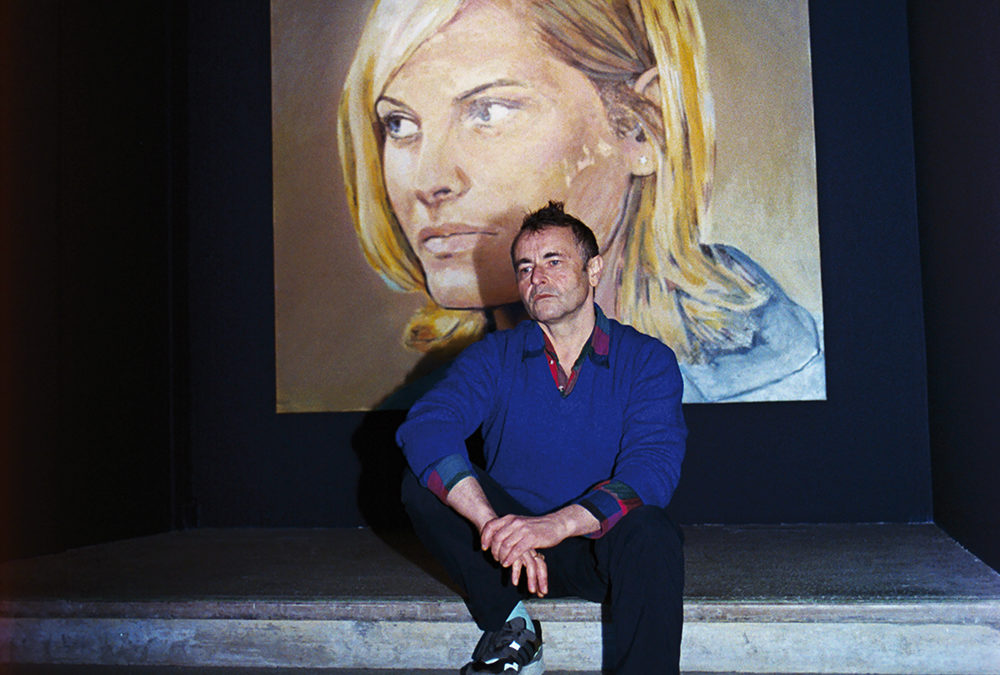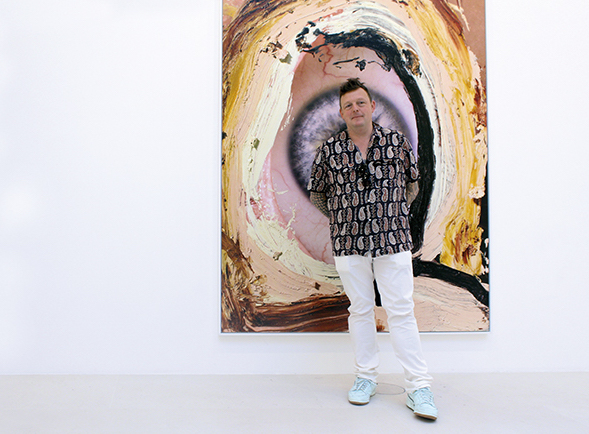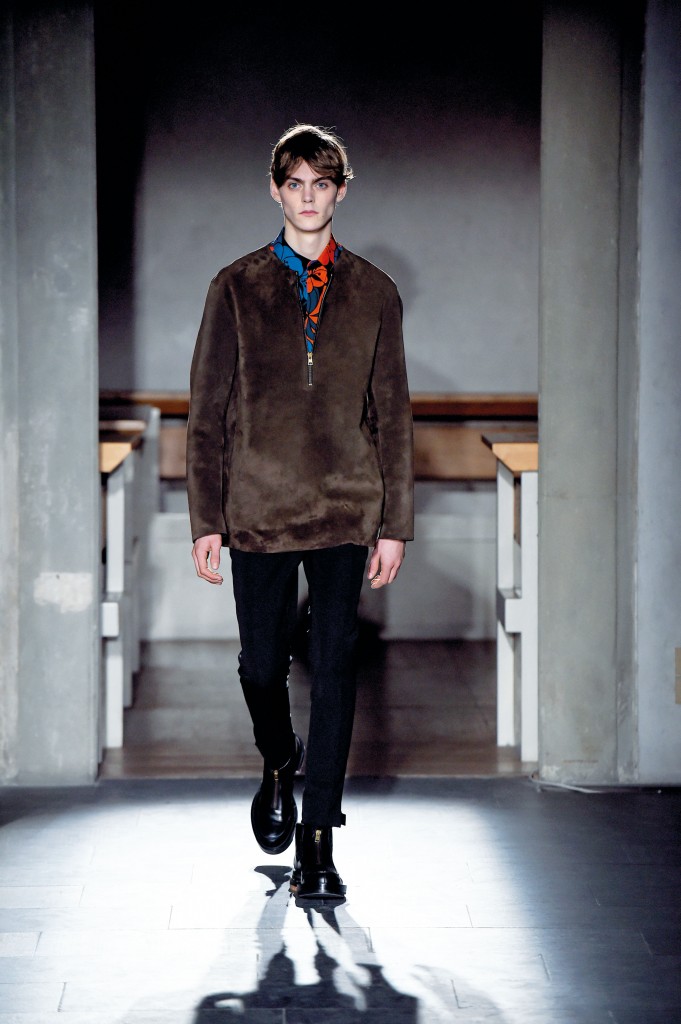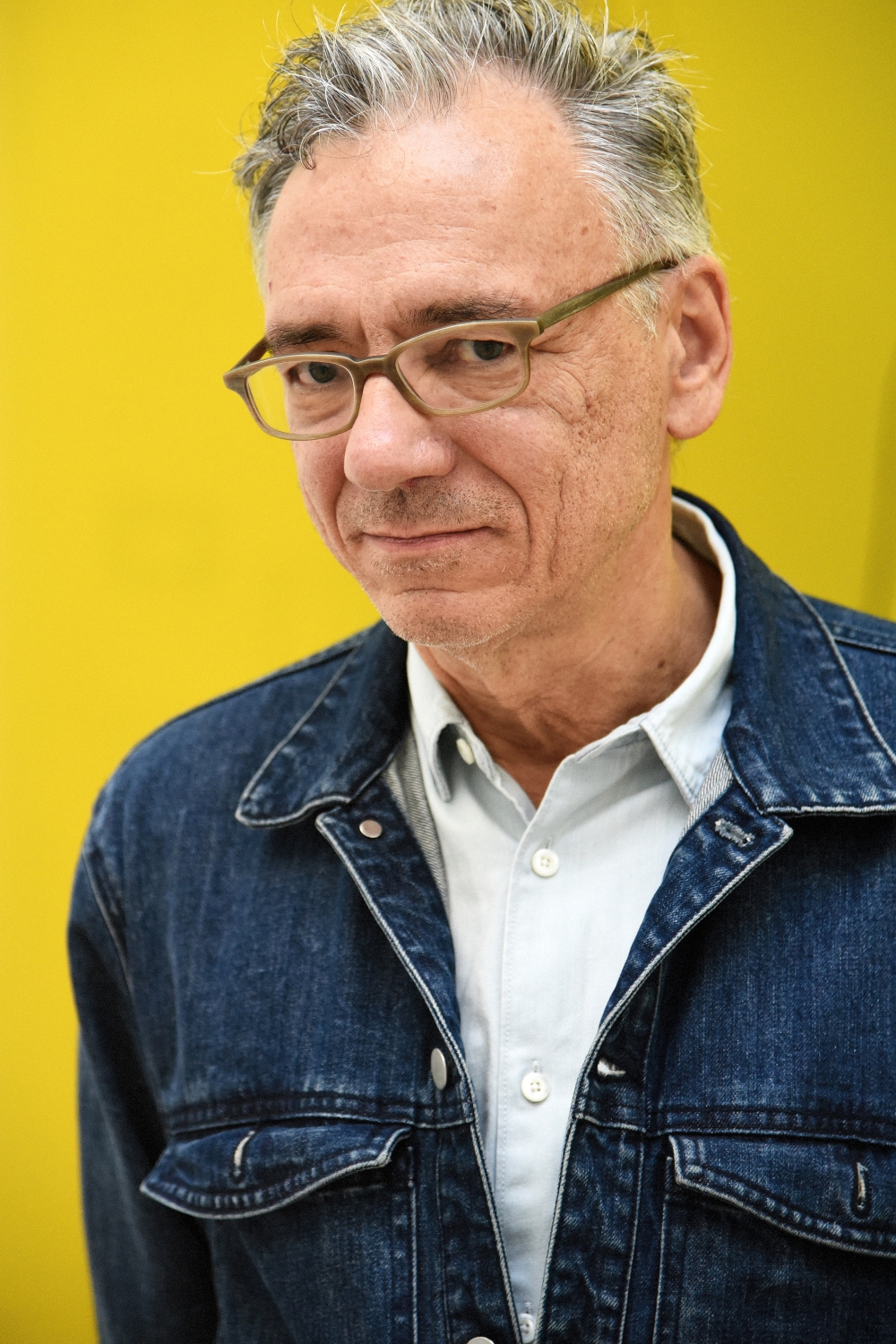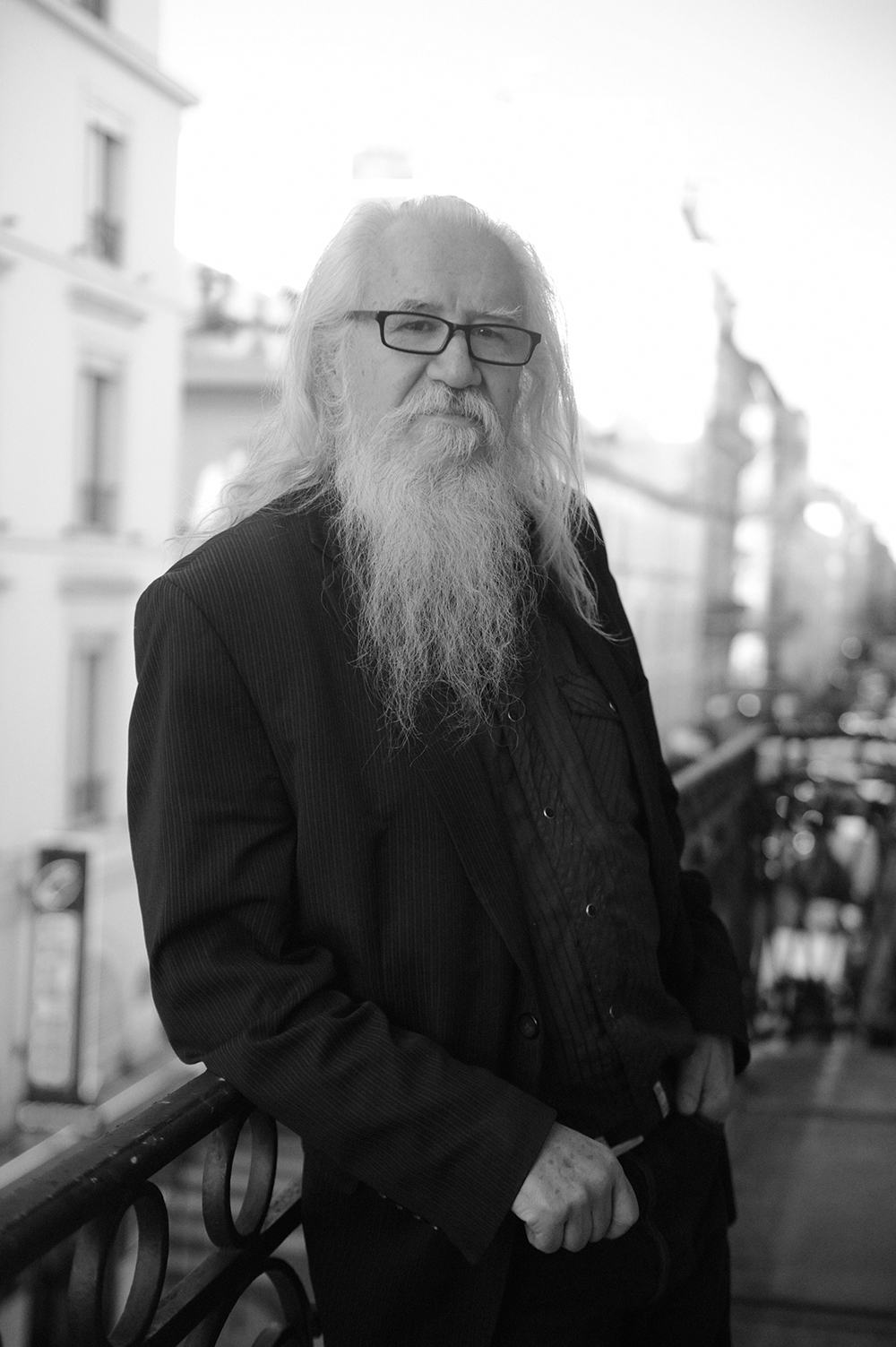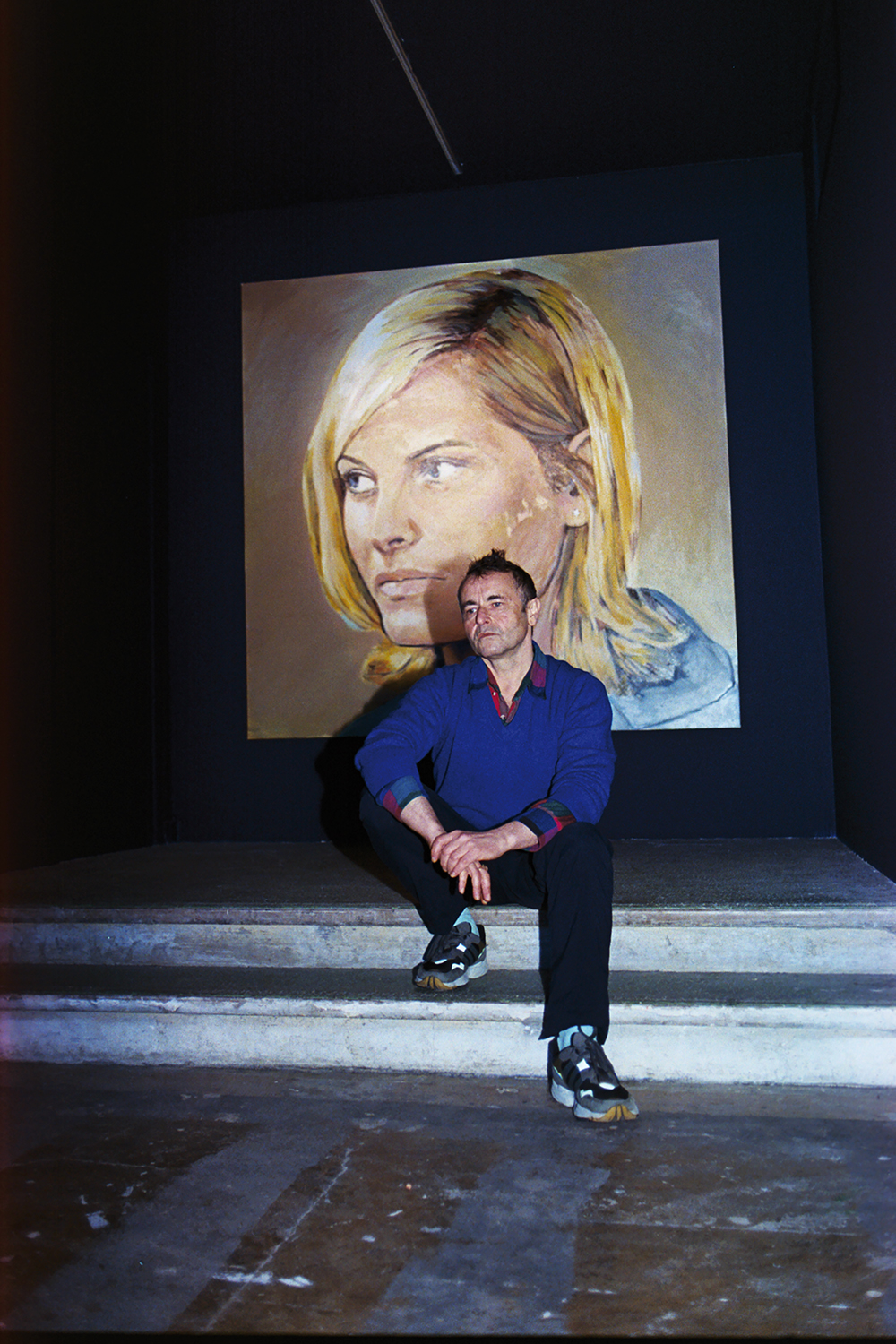
Sans titre, 2006, oil on canvas, 200x200 cm, "Futur, Ancien, Fugitif" exhibition, Palais de Tokyo, courtesy Art: Concept, Paris
A MEETING WITH JEAN-LUC BLANC
By Lise Guéhenneux
The context in which Jean-Luc Blanc’s artistic practice unfolds is that of an adventure oscillating between different systems of images. The soundtrack of this adventure would likely feature a doubled voiceover embracing all the energy unleashed by stories that may begin with a landslide in a village outside Nice, before shifting between multiple locations haunted by characters and mysterious objects, places where one might forget things which later reappear, like ghosts summoned by the artist to interact with tales from film history, rediscovered images and reactivated drawings. In this way, our interview becomes an ecstatic experimentation in the various languages he has manipulated since the early 1990s.
Lise Guéhenneux: Do you have any thoughts on the notion of experimentation in relation to your practice, which encompasses several systems of images, including painting and film?
Jean-Luc Blanc: There are many different types of experiments. There is the kind of experimenting that happens when grappling with the materiality of painting, approaching images as if they were actors. You often veers off from your initial desire when extracting an image from a specific location, which causes a transfer to take place. You choose an image because it tells you that you can control the situation when you come across an issue that is impossible to resolve. Such questions about the order of representation then participate in the experiment. To what extent can we share a vision? So with experimentation, there is the thing you want others to understand, the thing you are trying to build, meaning a space that is not entirely utopian.
Utopian? What exactly does this term encompass?
While I do not do this in a very calculated way, though I still feel it every time like the backwash of a wave, there is always a notion of time and space that are established from one painting to another, like in video when you shoot record various shots and then calibrate them, you correct their color so they fit together. I didn’t know what calibration was until I practiced it myself last year when I was invited to Le Plateau for the exhibition “La Rivière m’a dit”. For example, if there is no calibration in film, light will enter from different sides of the shot and you no longer have any temporal continuity. It’s like filming on a completely off-kilter planet. It’s not believable. In the exhibition space, the same thing occurs when you calibrate how different paintings hang on the wall.
In your practice, what is implied by mashing up a moving image with a still image like painting or drawing?
The sense of time found in painting is linked to the difficulty of finishing a painting. The painting with Mia Farrow (Untitled, 2009)[1] that is currently on display at the Palais de Tokyo was unfinished for ten years, and perhaps still is. I also like the kind of games you can play with still images. If I take a frame from a film, such as an image from Stephen Spielberg’s E.T., it’s not the film that is important fro me, but the frame taken out of context. I quickly forget about E.T. and all I retain is the glowing navel of a young child. In the photograph, it looks as though the light from the torch he is holding is coming out of his stomach. And when I go to draw that moment based on the photo, which is different than a simple sketch, I also like to draw what would come right after and right before that moment, so as to move towards a kind of movement. Because drawing and painting are determined by what you perceive at a very precise moment in your life experience. For me, painting is never abstract or figurative; it is part of the movement of an impulse which reaches towards what is represented and is amplified by the experience of the moment which sustains it. We see this very clearly in fantasy, whether in terms of literature or cinema, since it is a genre that questions this experience, this inability to solve an equation. The work is in fact an expression of the difficulty of solving or trying to solve an equation. In his unfinished work, The Sense of the Past, Henry James orbits around a work that we will never see. Similarly, Jacques Rivette deploys this same mechanism based on something secrete or withheld in his films.
How did you establish the calibration process used to index the images?
Let’s take a volume at random from the traumatic encyclopedia. When you do calibration, you are simply finding connections between colors, but it can create a curious unity in which the sense of time changes from one image to the next Brion Gysin and William Burroughs talked about the Third Mind to describe the relationship between two images. But experimentation is actually a part of us because our body is an experimental machine. From another angle, when I think about the word experimental, I would notably link it to the impossible book, Finnegans Wake by James Joyce, which can create links between images, while their meaning and feeling generate a somnambulistic memory, turning words into images and painting into words again. Within a painter’s practice, there is inevitably the part you store with your sensations that builds up a certain energy within you, and this fully palpable energy constitutes a transfer. It’s this energy that constitutes your material and generates another energy. You are the material of this absence which crystallizes into the work. It’s a way of taking the time to understand things. And by trying to understand them, you solve other things. I use painting because it is a privileged moment when you can leave the world without being passive, because you are not there. But at the same time, in the end, you have living matter at your disposal. “How can you silence language without biting your tongue?” This is a sentence I wrote with a friend Dragan in the studio. It means that a certain point, things merely scrape against each other without finding a true equivalent. Trying to solve this mystery is actually quite exciting. We don’t paint simply for the pleasure of painting; we paint to learn what we are doing when we are doing it. And after doing it, we try to see what happened, so we can create our own history.
How did you build the body of images for your traumatic encyclopedia?
I was given boxes of them and I had to find a way to organize all these little treasures that were entrusted to me. For ten years, I kept the archives of an actress friend, Maïté Mahïr, who did a lot of experimental theatre in the 1970s and 1980s… It was about thirty boxes in my workshop. One day, I decided to do something with them, so I started tearing them up for days on end. It turned into a game. Mentioning that makes me think about these wonderful images of Serge Daney when he was composing his page for the column “Les fantômes du permanent” in Libération (1986-1991). You can see, for example, how he adjusts the text to suit the image of Sergei Paradjanov. On a smaller scale, I always see myself in an editorial role, painting the book in a mystical dimension.
Do you follow any specific plan or logic?
What brings the images together is their structure – for lack of a better word – including their grain, colorimetry and printing since it involves ink. The same painting may be unrecognizable when cut out from different publications, so I don’t have the impression of using it as a model, more like a test subject allowing me to make an image that is no longer quite the same. The particularity of painting lies in these detachments. It’s a medium that can appropriate everything, which makes the capture a completely autonomous process.
Can you clarify what you mean by capture?
The idea of capture is mainly about compiling albums. There is something feverish about that activity, when you know you need to find an intermediate image.
When it comes to this sort of montage, which sets still images in motion through a relationship of exchange created by spatial proximity, does it satisfy your desire for cinema which came to you through a kind of epiphany?
Masculin Féminin was on TV during Christmas one year, when I was 13 or 14 years old and I didn’t know Godard, and I saw something happening: I saw people who were talking to me, I saw something that was real, something that made sense to me. I was left alone with this film and I thought, “I am saved”, at a time when I wasn’t able to adjust my inner world as a child to the world conveyed to me by my immediate surroundings. Then I watched Godard’s movies over and over again. Then it was Marguerite Duras. Her idea of filming the Lorry[2] script because she didn’t have the budget liberated me to make drawings that function as a script, an impossible script. It’s just a thin outline that doesn’t require a massive budget and forces you to be a little more hands-off. But I still managed to direct three U-matic films during the five years I spent at Villa Arson. And then there is Klossowski who started a business with his drawings because his brother Balthus refused to illustrate Roberte Ce Soir (1953).
Is drawing a privileged field of experimentation in your practice?
My practice involves a kind of infinite drawing process, which is based on a matrix made up of former drawings I keep in black binders. When I need to draw a new picture, I take out a drawing at random, place a blank sheet of paper on top, and spray it with turpentine. The old drawings mix with what I see today and reappear in a different way. So these are old drawings that I remodel endlessly because I think it’s fun to replay their energy. When I have to exhibit, I take my binders with me and take out whatever I want to show.
How did you implement this turpentine technique?
The turpentine was an accident. A painter friend, Olivia Boudet Fenouillé, was sitting next to me and his turpentine dripped onto my pile of drawings. As I was drying them on a long table, I noticed my drawings becoming transparent as I peeled them apart and so I thought I could tattoo the drawing. It’s like photoshop but it smells a lot stronger. In summer, you have about seven to ten minutes to finish the drawing because once it is dry, you can’t do anything else. It’s a timed challenge.
Imagining you playing with these ghostly images suggests an interesting parallel with developing photos.
All the way! The drawing on the bottom changes aspect. It opens up a world of possibilities in terms of reinterpreting the drawings, and it lets you move fast with your pencil. If you did the same thing with a light table, you would get a very thin line, whereas in this case you can achieve bolder lines.
The thick graphite binds with the turpentine.
It sets completely into the paper and you can no longer erase the image. Drawings made with this process always have to be reactivated. After the first draft, I come back to it once it has dried somewhat and paint on top of it.
An accident is a bit like an experiment, don’t you think?
Yes, you keep the door open to things that may not appear entirely orthonormal, but for me an accident is the triangulation of a desire that is never satisfied.
[1] Taken from See No Evil, Richard Fleischer, 1971.
[2] (The Lorry, 1977)
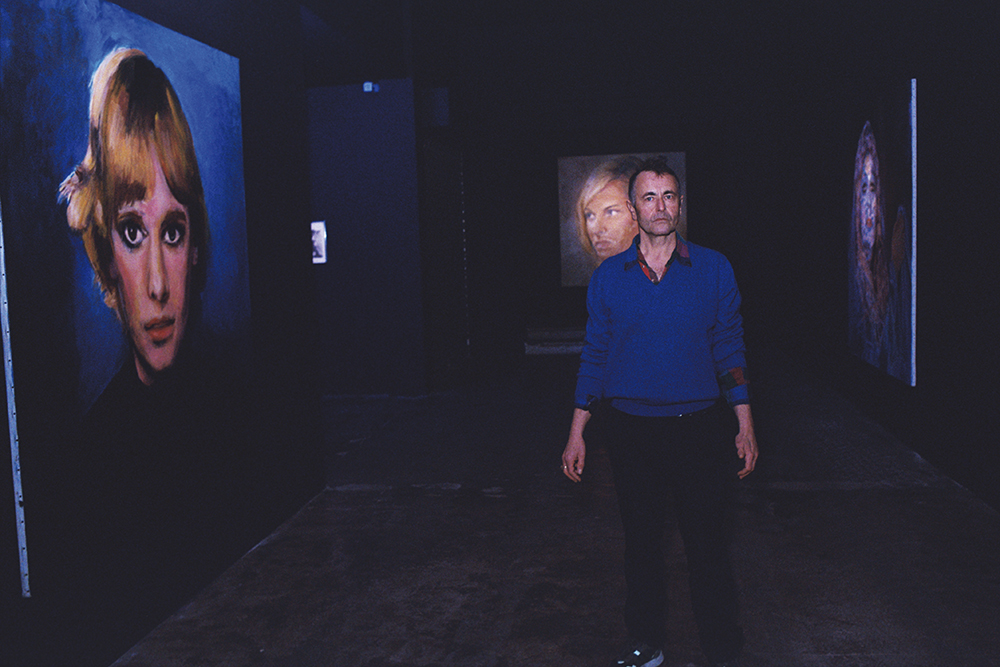
From left to right: Rosemary, 2009, 200x200, oil on canvas, courtesy Art: Concept, Paris
Sans titre, 2006, 200x200, oil on canvas, courtesy Art: Concept, Paris
Nora Miralda (d’après Serge Diakonoff), 2019, 200x200, oil on canvas, courtesy Art: Concept, Paris
« Futur, Ancien, Fugitif » exhibition, Palais de Tokyo
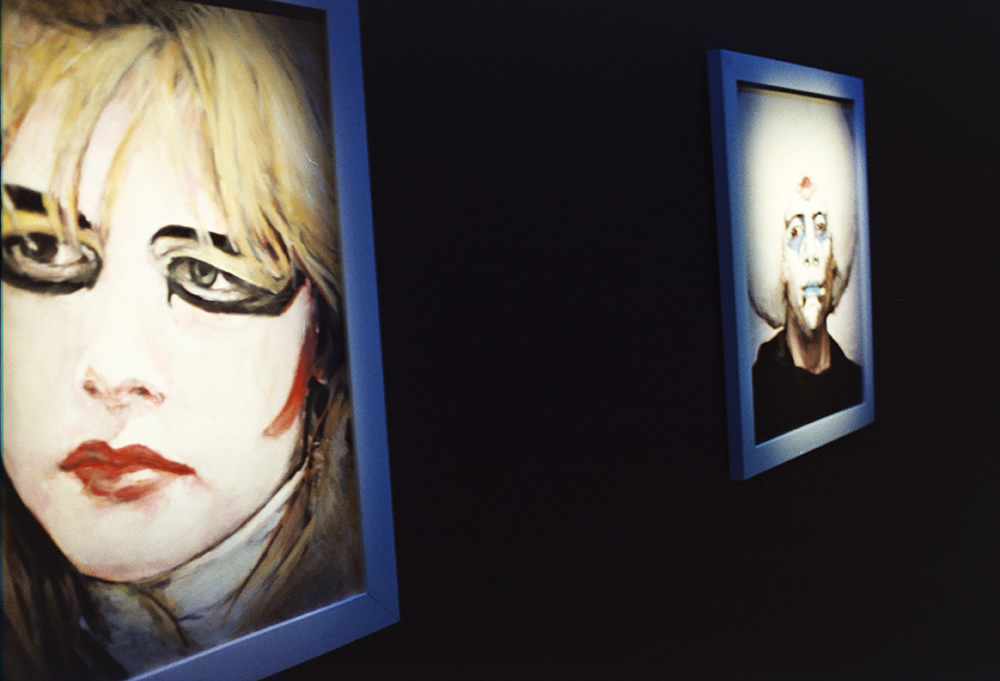
From left to right: Sans tire, 2005, 80x60, oil on canvas, Collection Irié, Paris
Sans tire, 2005, 80x65, oil on canvas, Collection Irié, Paris
« Futur, Ancien, Fugitif » exhibition, Palais de Tokyo
***
Interview by Lise Guéhénneux
Photos by Bertrand Jeannot
This meeting was originally published in Crash #90.







